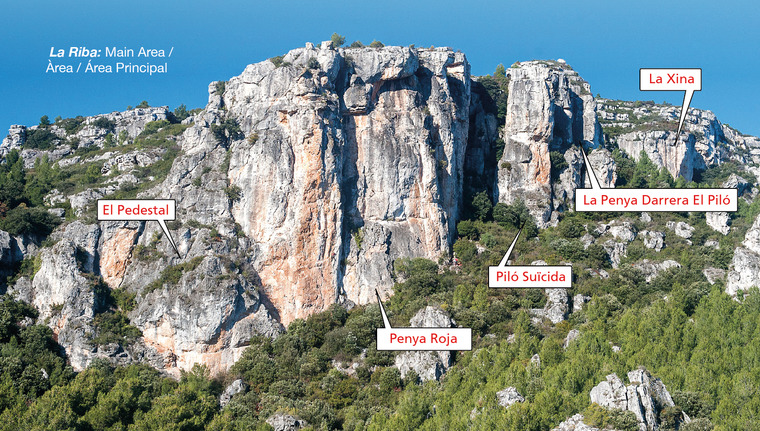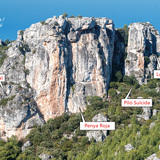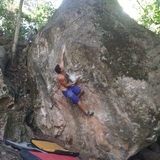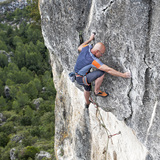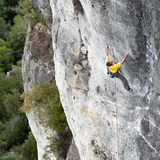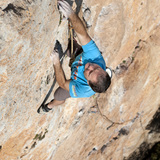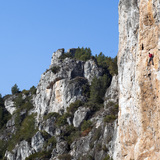General Description: This wonderful and historic climbing area, situated in the delightful valley of the River Brugent, just west of the town of La Riba, is one of Tarragona’s oldest sport-climbing venues, with the great majority of routes having been established during the 1980s. The zone will mostly appeal to climbers operating between V and 7a, though there are a few harder routes. The majority of cliffs have a southeasterly orientation meaning climbing in La Riba can be a year-round activity, with excellent conditions to be found both on mid-winter mornings and early afternoons, as well as breezy summer evenings. Furthermore, the rock is extremely quick to dry-out, even after prolonged rainfall.
General Approach: From the C-14 follow the TV-7044 uphill through the town of La Riba then continue driving west for approximately 1.5km to an obvious parking area directly opposite the cliffs on the other side of the river.
Sectors and Approaches
EL PEDESTAL
A short sector featuring steep, athletic climbs. Some of the routes are polished, especially the starts. Orientation southeast — sunshine until mid-afternoon.
Approach: From the parking follow an obvious path down into and across the riverbed, then past a derelict mill (El Molí de la Font Gran) heading directly towards the cliffs. The first section of rock reached is El Pedestal (10 minutes).
LA PENYA ROJA
Description: A very nice sector with many excellent climbs on great rock, although some of these are quite polished. Orientation southeast — sunshine until mid-afternoon.
Approach: From the parking follow an obvious path down into and across the riverbed, then past a derelict mill (El Molí de la Font Gran) heading directly towards the cliffs. The first section of rock reached is El Pedestal; just beyond this lies the start of Penya Roja (10 - 12 minutes).
PILÓ SUÏCIDA
Description: An impressive pinnacle. The most popular climb is a combination of Gitano Blanc followed by the second pitch of Alegre-Bonet.
Approach: From the parking follow an obvious path down into and across the riverbed, then past a derelict mill (El Molí de la Font Gran) heading directly towards the cliffs. Continue uphill, passing El Pedestal and Penya Roja to reach the obvious tower (12 minutes). Orientation southwest — shade until mid-afternoon.
LA PENYA DARRERA EL PILÓ
Description: A very nice sector with good, grey rock. Orientation southeast — sunshine until mid-afternoon.
Approach: From the parking follow an obvious path down into and across the riverbed, then past a derelict mill (El Molí de la Font Gran) heading directly towards the cliffs. Approximately halfway between the river and the cliffs, while passing a large boulder on the left, a well-marked trail cuts right off the main path and heads first rightwards and then straight up the wooded hillside, passing to the right of a large pinnacle. Shortly after this the terrain begins to level out and the path splits by a metal signpost: take the left fork (marked Cim de la Penya Roja), which leads up and left to the sector (12 minutes).
It is also possible to approach this sector from the upper right-hand part of Penya
Roja, passing below Piló Suïcida and continuing up the ever-fainter trail for a further 25m, then scrambling up a short gully on the left (fixed rope) to ledges below the routes (15 min). Note: If using the first approach described it is necessary to descend the fixed rope in the gully to reach the base of climbs 2 - 12.
LA XINA
La Xina was the site of one of Spain’s earliest climbing competitions (when they were still held outdoors) and many of the routes have been ‘created’ to some degree. However, the climbing is excellent, athletic and pumpy. Orientation: east for the right-hand side of the sector, south for the left-hand side.
Approach: From the parking follow an obvious path down into and across the riverbed, then past a derelict mill (El Molí de la Font Gran) heading directly towards the cliffs. Approximately halfway between the river and the cliffs, while passing a large boulder on the left, a well-marked trail cuts right off the main path and heads first rightwards and then straight up the wooded hillside, passing to the right of a large pinnacle. Shortly after this the terrain begins to level out and the path splits by a metal signpost: take the right fork (marked La Xina), which leads up and left to the sector (15 minutes).
LA CONXINXINA
Description: This attractive sector actually overlooks the town of La Riba, but is not approachable from there. The rock is very compact, giving technical climbing on small holds. Note: for better or worse, this sector contains a mixture of sport and trad routes. Only the fully bolted routes appear in our topo (although, confusingly, some of the ‘trad’ climbs also feature the odd shiny bolt).
Approach: Begin by following the approach for La Xina/La Penya Darrera El Piló. From the right-hand side of La Xina, continue rightwards on a vague trail passing through jumbled boulders (many cairns). The trail soon reaches the wooded plateau above the crags and becomes more distinct. Keep right at the first bifurcation then continue walking in the same direction, following the trail back down below the cliff line until a short ascent leads up to the base of the left-hand side of the sector (20 min. from La Xina, 35 min. from P).
CAL GALLINERS
A small sector but with perfect rock. Orientation southeast — sunshine until mid-afternoon. The equipment is not in great condition.
Approach: from the parking area, walk up the road for approximately 100m and then step over the crash barrier and descend a steep trail down to the river. Follow the riverbed upstream for some 80m until directly below the sector. A path leads through bushes (cairn where it begins) and up a short gully to the base of the left-hand side of the sector (10 min). Note: this approach is not possible if the river is running high!
LLOSA NEGRA
A small but worthwhile sector with some nice routes. Orientation southeast — sunshine until mid-afternoon.
Approach: from the parking area walk up the road (west) for approximately 400m and locate a metal signpost on a boulder for ‘Llosa Negra’ marking the start of a path descending into the riverbed. Cross the river diagonally rightwards and continue along a vague trail to a fixed rope hanging down a steep corner. Climb this (not easy with a heavy rucksack) to a rocky terrace then scramble up and left to the base of the sector (10 minutes). This approach is unsuitable for non-climbers and dogs.
LO TERRALL
Description: An old sector, which has recently been cleaned and rebolted, with several new routes equipped at the same time. Orientation: southwest — sunshine after midday.
Approach: from the parking area walk up the road for approximately 650m passing the start of the Llosa Negre approach. Some 50m after passing a ruined dwelling on the left-hand side of the road, a cairn on the right marks the start of a path. Follow this down into and across the (normally) dry riverbed, then ascend an old concrete water channel up and leftwards. From the top of this, a fixed rope helps overcome a short steep wall and leads to a terrace. The first routes start a few metres to the left (12 minutes from the parking area).
ELS TRES PILANS
Description: The routes in this sector are situated on small pinnacles in a very secluded valley. In recent years, many more routes have been added and the older climbs re-equipped. Orientation: mostly north or west. A great sector for mornings when other sectors in La Riba will be uncomfortably hot, but not so great in winter…
Approach: from the parking area walk up the road (west) for approximately 750m then turn left onto a semi-hidden footpath (cairn at the start) leading up into a narrow side-valley. The first 3 climbs are situated on a wall laying up and to the left of a boulder-arch, some 50m from the road, with a 4th climb on the inside of the arch itself. The next few climbs lie on a buttress immediately after the arch, but the bulk of the routes, including those on the attractive twin pillars forming the focus of the sector, are situated some 150m further up the valley (15 - 20 min).

